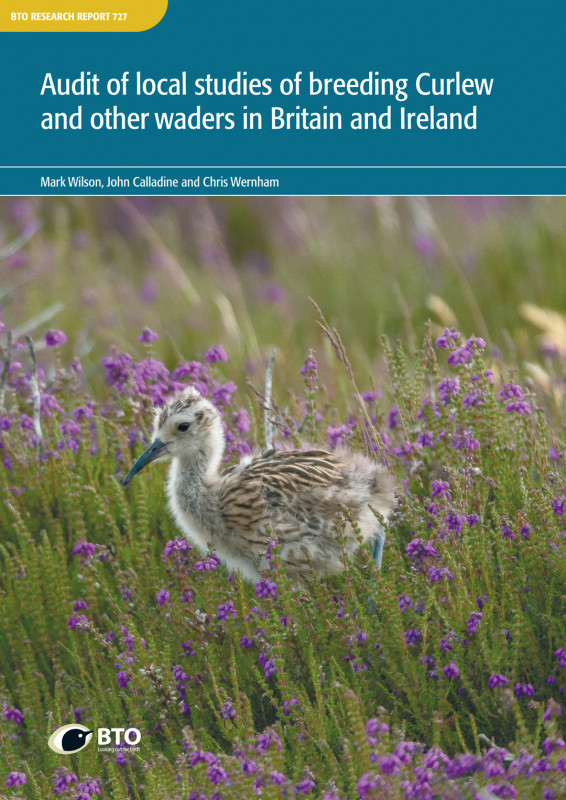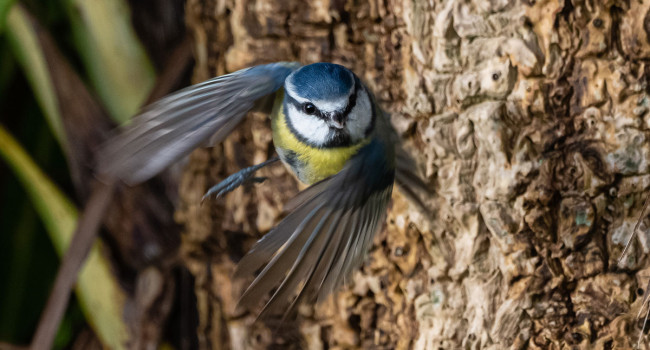Audit of local studies of breeding Curlew and other waders in Britain and Ireland
Author(s): Wilson, M., Calladine, J. & Wernham, C.
Published: June 2020 Issue No.: 727
Publisher: British Trust for Ornithology Pages: 40pp
ISBN: 978-1-912642-18-2
Download article 6.18 MB application/pdf
Abstract
1. Due to large historical and ongoing population declines in Britain and Ireland and mainland Europe, and its ‘near-threatened’ global status, the Eurasian Curlew (Numenius arquata) is widely considered by many stakeholders to be one of the highest bird conservation priorities in the UK and Ireland. A number of other breeding waders have also showed marked declines during a similar time frame, and a multitude of field initiatives across Britain and Ireland have been established, or tailored, to support conservation of these wader species.
2. This audit aimed to collate information from as many of these British and Irish breeding wader projects as possible, to allow BTO to assess how best it might assist local to national initiatives through partnership working in future. The audit was designed to assess the appetite of the interested community for scientific guidance, mechanisms to share data and findings, and any other roles that would benefit from BTO’s areas of expertise and experience.
3. This report presents information drawn from a variety of projects on breeding Curlew and other waders. Questionnaires were sent out to 41 projects in October 2017, asking about their structure, aims, and monitoring and management activities. We also carried out a literature review of breeding wader survey
methodologies.
4. Questionnaire responses were received for 31 projects. The majority of projects had been started recently, but with the intention of carrying on for as long as funding permitted.
5. The geographic scope of projects varied greatly, from individual farms and discrete areas of good wader habitat, to much larger areas, typically with very low wader densities. Several projects covered multiple areas.
6. Almost half of the projects that responded were led by RSPB, but several were organised and carried out principally by independent individuals. The remainder were led by staff in National Parks or Areas of Outstanding Natural Beauty, University of the Highland and Islands, and BTO.
7. Many projects relied extensively or exclusively on volunteer input of manpower and expertise. Where projects had access to internal funding from hosting organisations, or external funding from grants and donations, this was typically time-limited or of uncertain duration.
8. Most projects carried out counts of breeding waders. The majority of these used standard wader survey techniques. Two others employed transect surveys, and three focussed on finding breeding pairs at historic breeding sites in areas of low density. Three more projects, in areas managed for grouse shooting, were undertaken by gamekeepers during their daily routines.
9. Fewer projects carried out nest monitoring or engaged in systematic recording of breeding productivity. Most respondents acknowledged the importance of productivity information, but many felt constrained by lack of resources as well as uncertainty about which methods would be most suited for them to use.
10. Six projects carried out colour-marking and/or remote-tracking of Curlews, aimed primarily at improving understanding of the factors influencing chick survival, and local movements of adults.
11. More than half of the projects collected information on habitat quality and (particularly agricultural) land management. Only one project claimed to collect systematic information on occurrence or activity of predators, though several others recorded data on predators opportunistically. Four projects looked explicitly at food availability for breeding Curlews.
12. Roughly half of the projects included work on habitat management. In some cases this was carried out directly by project participants, while other projects gave advice to and made agreements with farmers – often in the context of applications for funding under agri-environmental schemes.
13. Methods aimed at systematically counting breeding waders are well developed, with the literature containing much useful advice on timing of surveys (within day and season), number of surveys, the information that surveyors should record and how this should be interpreted
14. Determining nest success (i.e. hatching success) of waders is reasonably straight-forward, though finding and monitoring wader nests can be time-consuming. However, wader chicks leave the nest soon after hatching and do not fledge for another 2–4 weeks. This makes nest success an unreliable signal of overall breeding productivity, which is of greater overall significance.
15. Methods for assessment of breeding productivity are less well developed. Although many different approaches are described in the literature, many of these are time-consuming, and there is often a lack of consensus regarding which approach is most appropriate. Moreover, little consideration is given to how the findings from different methods should be compared with one another.
16. Many stakeholders would appreciate the provision of guidance on methods for wader monitoring in more user-friendly forms than currently exist. Such guidance should steer fieldworkers towards the survey types that are best suited to their situation, and give specific advice about aspects such as timing, effort and sampling design.
17. Guidance on collection of breeding productivity data should emphasise the lack of consensus on how best to do this, and the importance of documenting details of methodology. This will enable information collected to contribute to assessments of what works best for determining productivity in different situations, and will better place projects to take advantage of new developments in this area.
18. There is wide recognition that a system to effectively capture wader monitoring data would be useful not only to individual projects, but also to the wider wader conservation community. Such a system would need to be flexible enough to accommodate a wide range of users and types of information. Most stakeholders would be willing for their data to be widely shared to promote and enhance wader conservation efforts.
19. Improved monitoring of waders could be aided through the appointment of a Wader Project Officer. The role could include over-arching support for individuals and organisations working on waders, promotion of best practice, encouraging synergies and helping to guard against duplication of effort, and management and development of a wader information hub.
20. The resource-limited nature and common objectives of many wader projects are well suited to partnership working. As well as boosting the efficiency and effectiveness of initiatives to monitor and manage waders, partnerships between different groups of stakeholders are likely to result in opportunities for knowledge transfer, and increased mutual understanding and tolerance of stakeholders with potentially divergent views.
Notes
This work was funded by the Esmée Fairburn Foundation. Richard Boddington helped to expand the scope of the literature review. Sam Franks, Rachel Taylor, Katharine Bowgen, Ben Darvill, David Jarrett and other colleagues at BTO gave helpful advice on the questionnaire, and Sam Franks made valuable constructive comments on an earlier draft of this report. Collaborators in Working for Waders and members of the Southern Curlew Forum helped to circulate the questionnaire to relevant projects. In Scotland, efforts to gather and share information about wader projects are being continued by Working for Waders, and can be found here: http://waders.hutton.ac.uk/. Finally, a big thank you to all the people who filled in questionnaires, or who took time to contact us about their projects. Keep up the good work!









Share this page